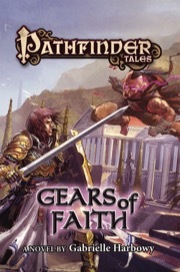Deborah J. Ross's Blog, page 87
March 13, 2018
Today's Wisdom from Middle Earth
"Yet the deeds will not be less valiant because they are unpraised."
― J.R.R. Tolkien, The Return of the King
― J.R.R. Tolkien, The Return of the King

Published on March 13, 2018 01:00
March 9, 2018
Short Book Reviews: Freedom and Autonomy in a Robotic World
 Autonomous, by Annalee Newitz (Tor)
Autonomous, by Annalee Newitz (Tor)My quick take on this book is “feminist anarchist new-wave cyberpunk,” but that doesn’t do it justice by a long shot. In a world dominated by pharmaceutical companies, illegally reverse-engineered drugs offer the only hope to the poor. But when her attention-focusing drug creates lethal obsession, rogue scientist Jack desperately tries to get her pirated version off the streets. That’s half the story and I was already hooked (scientist heroes, check; women scientist heroes, double-check). The second half of the story centers around the private military team (human Eliasz and robot-with-human-brain Paladin) dispatched to apprehend Jack. That’s where things get really interesting, because in this dystopic world, robots are chattel and sometimes so are people. Both can earn their freedom, but what does that really mean?
Once bots gained human rights, a wave of legislation swept through many governments … became known as the Human Rights Indenture Laws. They established the rights of indentured robots, and, after a decade of court battles established the rights of humans to become indentured, too. After all, if human-equivalent beings could be indentured, why not humans themselves?
“For bots, industry always precedes autonomy,” explained a final string of text.
Legal autonomy, emotional independence, freedom from obsession and pharmaceutical control of mood, thought, and desire? Newitz deftly blends the themes and resonances into a dramatic story that feels refreshingly current and yet fits easily within the genre. I look forward to her next work.
The usual disclaimer: I received a complimentary review copy of this book through NetGalley, and nobody paid me to hold my own opinions about it.

Published on March 09, 2018 01:00
March 7, 2018
I'll Be at FogCon -- See You There?
At the last minute, I've decided to attend FogCon. I badly need to run away and hobnob with my tribe. No panels, but lots of schmoozing. If you see me, please come say hello.

Published on March 07, 2018 18:34
Today's Moment of Art
Published on March 07, 2018 01:00
March 6, 2018
Today's Wisdom from Middle Earth
"This quest may be attempted by the weak with as much hope as the strong. Yet such is oft the course of deeds that move the wheels of the world: small hands do them because they must, while the eyes of the great are elsewhere."
― J.R.R. Tolkien, The Fellowship of the Ring
― J.R.R. Tolkien, The Fellowship of the Ring

Published on March 06, 2018 01:00
March 1, 2018
Short Book Reviews: A New Pathfinder Tale
Gears of Faith (Pathfinder Tales) by Gabrielle Harbowy (Tor)

One of the tests of a shared world is how accessible the stories are to a reader who is a stranger to that world. Pathfinder is an extremely popular fantasy role-playing game (along the lines of Dragons and Dungeons, for non-gamers like me). There’s a wealth of material about the various landscapes, races, characters, and histories of the world, and a series of novels (over 30 of them) set in it. This current addition includes a glossary and maps to aid the unfamiliar traveler.
The set-up is this: two characters (Keren, a knight dedicated to the goddess Iomedae, who incidentally was once human; and Zae, a violet-haired gnome who is both a fanatic tinkerer-inventor-engineer and a mystical healer; oh, and also incidentally, they are both female and are lovers) arrive in the great city of Absalom to continue their respective training, only to find themselves caught up in a series of increasingly violent attacks that center on the theft of a supernatural device. The story weaves together mystery, action, romance, with the question of the proper balance between trusting one’s sense of what is right and obedience to a higher authority. Pacing allows the newcomer to explore this colorful world while falling in love with the characters, yet there is sufficient drama and escalating tension to keep a familiar reader turning the pages.
My favorite parts were the scenes of Zae in her engineering classes, with lively dialogs with her fellow students (of various races and temperaments) and the inevitable results of her fearless curiosity. Her mount, a large dog named Appleslayer, adds warmth to the family. Plus, it’s very cool to have a dog as a companion on a quest.
The usual disclaimer: I received this book as a gift; everything I've said about it is my own opinion and no one paid me to say nice things; are you happy now, FTC?

Published on March 01, 2018 01:00
February 28, 2018
Today's Moment of Art
Published on February 28, 2018 01:00
February 27, 2018
Today's Wisdom from Middle Earth
“Even the smallest person can change the course of the future”
― J.R.R. Tolkien, The Fellowship of the Ring
― J.R.R. Tolkien, The Fellowship of the Ring

Published on February 27, 2018 01:00
February 26, 2018
White Dwarf Stars and Other Wonders
White dwarf’s inner makeup is mapped for the first time

Tiny changes in a white dwarf’s brightness reveal that the stellar corpse has more oxygen in its core than expected, researchers report online January 8 in Nature. The finding could challenge theories of how stars live and die, and may have implications for measuring the expansion of the universe.
As a star ages, it sheds most of its gas into space until all that remains is a dense core of carbon and oxygen, the ashes of a lifetime of burning helium. That core, plus a thin shellacking of helium, is called a white dwarf.
Luckily, some white dwarfs encode their inner nature on their surface. These stars change their brightness in response to internal vibrations. Astrophysicists can infer a star’s internal structure from the vibrations, similar to how geologists learn about Earth’s interior by measuring seismic waves during an earthquake.
Saturn’s rings, made of countless icy particles, form a translucent veil in this view from NASA’s Cassini spacecraft.

Saturn's moon Titan sports Earth-like features

Using the now-complete Cassini data set, Cornell astronomers have created a new global topographic map of Saturn's moon Titan that has opened new windows into understanding its liquid flows and terrain.
The map revealed several new features on Titan, including new mountains, none higher than 700 meters. The map also provides a global view of the highs and lows of Titan's topography, which enabled the scientists to confirm that two locations in the equatorial region of Titan are in fact depressions that could be either ancient, dried seas or cryovolcanic flows.
The map also revealed that Titan is a little bit flatter -- more oblate -- than was previously known, which suggests there is more variability in the thickness of Titan's crust than previously thought.

Tiny changes in a white dwarf’s brightness reveal that the stellar corpse has more oxygen in its core than expected, researchers report online January 8 in Nature. The finding could challenge theories of how stars live and die, and may have implications for measuring the expansion of the universe.
As a star ages, it sheds most of its gas into space until all that remains is a dense core of carbon and oxygen, the ashes of a lifetime of burning helium. That core, plus a thin shellacking of helium, is called a white dwarf.
Luckily, some white dwarfs encode their inner nature on their surface. These stars change their brightness in response to internal vibrations. Astrophysicists can infer a star’s internal structure from the vibrations, similar to how geologists learn about Earth’s interior by measuring seismic waves during an earthquake.
Saturn’s rings, made of countless icy particles, form a translucent veil in this view from NASA’s Cassini spacecraft.

Saturn's moon Titan sports Earth-like features

Using the now-complete Cassini data set, Cornell astronomers have created a new global topographic map of Saturn's moon Titan that has opened new windows into understanding its liquid flows and terrain.
The map revealed several new features on Titan, including new mountains, none higher than 700 meters. The map also provides a global view of the highs and lows of Titan's topography, which enabled the scientists to confirm that two locations in the equatorial region of Titan are in fact depressions that could be either ancient, dried seas or cryovolcanic flows.
The map also revealed that Titan is a little bit flatter -- more oblate -- than was previously known, which suggests there is more variability in the thickness of Titan's crust than previously thought.

Published on February 26, 2018 01:00
February 23, 2018
Book Review: Into the Fire by Elizabeth Moon
 I pick up a new Elizabeth Moon novel with anticipatory delight. In its pages (or phosphors, for the ebook version), I will find fascinating characters with skills and intelligence, subtle conflicts of culture, superbly handled tension and plot twists, and insights into people who are different from me. Unlike the heroine of Into the Fire (and Moon herself), I have no military experience whatsoever (30 years of Chinese martial arts notwithstanding). I was a long-haired, sign-waving war protester. Most military fiction leaves me looking around for those love beads. But not Moon’s, and a big part of that (aside from her sheer story-telling skill) is the intelligence and compassion of her military characters.
I pick up a new Elizabeth Moon novel with anticipatory delight. In its pages (or phosphors, for the ebook version), I will find fascinating characters with skills and intelligence, subtle conflicts of culture, superbly handled tension and plot twists, and insights into people who are different from me. Unlike the heroine of Into the Fire (and Moon herself), I have no military experience whatsoever (30 years of Chinese martial arts notwithstanding). I was a long-haired, sign-waving war protester. Most military fiction leaves me looking around for those love beads. But not Moon’s, and a big part of that (aside from her sheer story-telling skill) is the intelligence and compassion of her military characters.In the previous novel, Cold Welcome, Ky Vatta and an assortment of people under her command and not-under-her-command manage to survive a shuttle crash into icy waters and make their way to an abandoned base in a frigid, barren landscape. Their survival depends not only working together and making the best decisions but a huge measure of luck. Ky’s training and experience give her a structure to establish leadership and discern what must be done, and by whom, and in what order, how to best use the skills of the others, how to resolve conflicts without squelching initiative. Most of the book centers on how leadership, delegation protocols, the balance between negotiation and creativity and obedience, and the skills to construct and carry out strategic planning can save lives. In fact, there’s very little shoot-‘em-up and a great deal of wow, these people have thought carefully about how to manage desperate situations. Into the Fire continues that story.
After the grand finale and rescue, Ky might think her ordeal is over. Ha! Her meticulously collected records of the sabotage go missing and her people mysteriously disappear, drugged and kept incommunicado by forces inimical to her family. The focus shifts from physical to political survival. Sabotage, betrayal, immigration raids, poisoning, and a rescue executed in typical Ky Vatta style build and sustain tension. Again I was impressed by the skillfulness with which Ky and her companions make and execute plans, whether it’s marshalling an academy full of unseasoned cadets to defend the planetary president or nab the drugged prisoners from several different locations. Ky didn’t just jump into action, as characters in many other military novels so often do. She didn’t say, “Trust me, just do what I say” to her subordinates. She conferred with those with expertise, made plans, revised them, revised them again, made backup plans and backups to the backups, made sure everyone had the information they needed to do the best, smartest job. Things went wrong, as of course they must in fiction. And that’s half the fun of the adventure.
Moon provides enough backstory for Into the Fire to stand on its own, but I recommend reading it together with Cold Welcome. And I do recommend it!

Published on February 23, 2018 01:00







